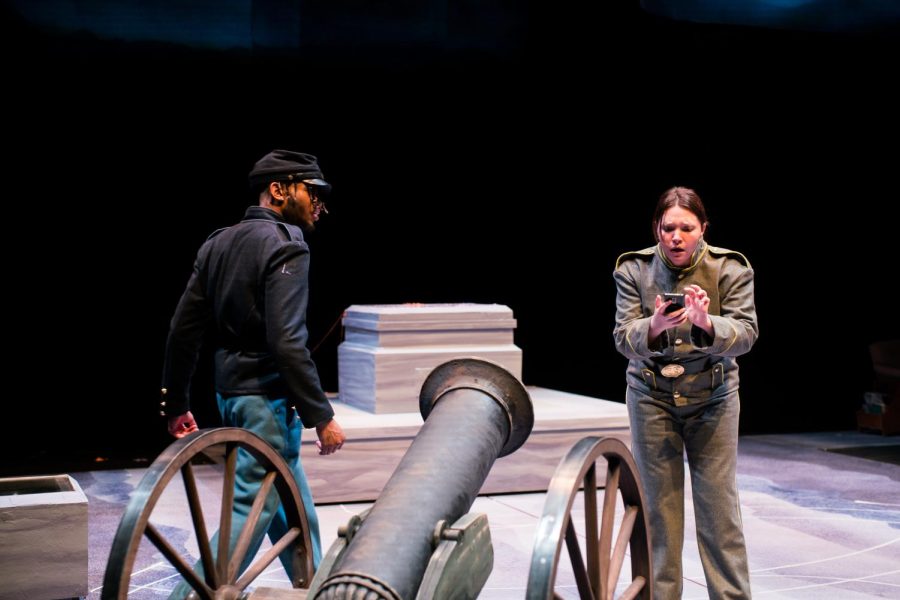Stonewallin’ Blends Fantasy, Comedy in Examination of Contemporary Issues
The Theater Department presents its Mainstage production Stonewallin’ this weekend.
In the mainstage theater production Stonewallin’, mountains engulf the audience. The stage consists of nothing but a couple pedestals, and the theater is framed by screens depicting smokey purple hills: an artistic yet realistic rendition of the landscape.
The first few moments of the play feel gravely serious — dim lighting, the cast members silent as they step up to the pedestals. The closest platform is mere inches from audience members, blurring the line between actor and audience. The actors themselves — rather than crew members — push a gravelike monument out on the stage. It soon became apparent that this was to be the main prop.
However, those first few weighted moments didn’t set the tone for the rest of the play. Very quickly, the production takes a humorous turn. The first scene is funny, both in the actors’ performances and dialogue. Arguably, the entire show is a comedy. Humor is threaded throughout and executed well. There are some purely lighthearted moments, such as an actor holding and pointing to a pear when talking about the city of Paris. Other moments are more deadpan; a grim sort of sarcasm in the face of ignorance, or even prejudice. However, the play never seems to make too much light of serious issues — the director and playwright, Visiting Assistant Professor of Theater Kari Barclay, walks a careful line to provide comic relief without being insensitive.
There are a lot of competing big-picture topics in the production — performative activism, colonialism, appropriation, and the conflict between Black Lives Matter and All Lives Matter. More nuanced, interpersonal matters appear as well, such as boundary setting and gender identity. All of these discussions are framed within the context of removing a statue with racist roots. It may seem from this description that putting so many subjects together might be overwhelming. Often, works that try to grapple with too much at once fall short of any real message. However, Stonewallin’ is adept at weaving its various themes together. The storyline is compelling and the political points never feel forced. Barclay combined a wide range of themes with powerful execution.
That said, some of these themes are difficult to address. They’re lofty and multifaceted. It’s difficult to figure out what’s right or wrong. Morally gray areas are brought up tactfully, such as a scene between two main characters as they are establishing terms of their relationship — one sets a boundary that she doesn’t want a romantic relationship with a man, while the other argues that they are not actually a man, but nonbinary. Both sides of the issue are presented as valid, with neither character being framed as a villain or victim. This allows the audience to truly reflect on the points made, rather than being forced into supporting one character or the other.
Equally important as the writing is the acting, which is excellent. With just a five person cast, it is essential that every character be played skillfully. Brooke Lynlee (Marsha Lyons) and College first-year Rowan Kozinets (Tommy Jackson) are superb main characters. Lynlee’s acting is spitfire, and Kozinets complements that energy. College fourth-year Tony Singfield (Elijah Lyons) has a sort of mediator role in the play and captures the nuance of the character well. College fourth-year Olivia Bross (Mamaw Jackson) and College second-year Ana Morgan (Stonewall Jackson) are notable as well — they play characters with not only big personalities, but questionable viewpoints at best. I imagine it would be difficult to portray characters with disagreeable attributes. Despite this, Bross and Morgan inhabit their personas well — providing comedic, realistic, and disturbing moments in the play.
The show as a whole felt quite intimate. Stonewallin’ took advantage of the Irene and Alan Wurtzel Theater by having moments where characters got up close and personal with the audience. One scene in particular stands out: actors directly addressed the audience, shouting a string of humorous insults. Resounding laughter often echoed in the theater, perhaps the best sign that the audience was enjoying the performance. The play had an experimental take on inter-character intimacy. A scene that started out as a simple kiss took a somewhat absurdist turn, morphing into an elaborate dance with mating calls that resembled those of birds. An argument can be made that this scene felt out of place. Aspects of it were jarring, such as the flashing lights and change in background music. On the other hand, is it fair to expect everything to remain realistic in a play about a statue coming to life?
On a technical note, some scene changes were disorienting. It seems that they were meant to keep the audience straight in the moment, but with minimal set pieces, it was sometimes hard to keep up. At one point, it was slightly unclear whether a scene was a dream, or an actual event in the play. Actors fluidly brought and removed their own stage props, whereas a typical stage crew would have provided a more clear marking of scene changes.
As a whole, the production was entertaining and thought-provoking. It was funny without lacking substance. It was pertinent to current day struggles without being despairing. The program describes it as “a spell to guide us through panic in the face of hate” — and it accomplished just that.











